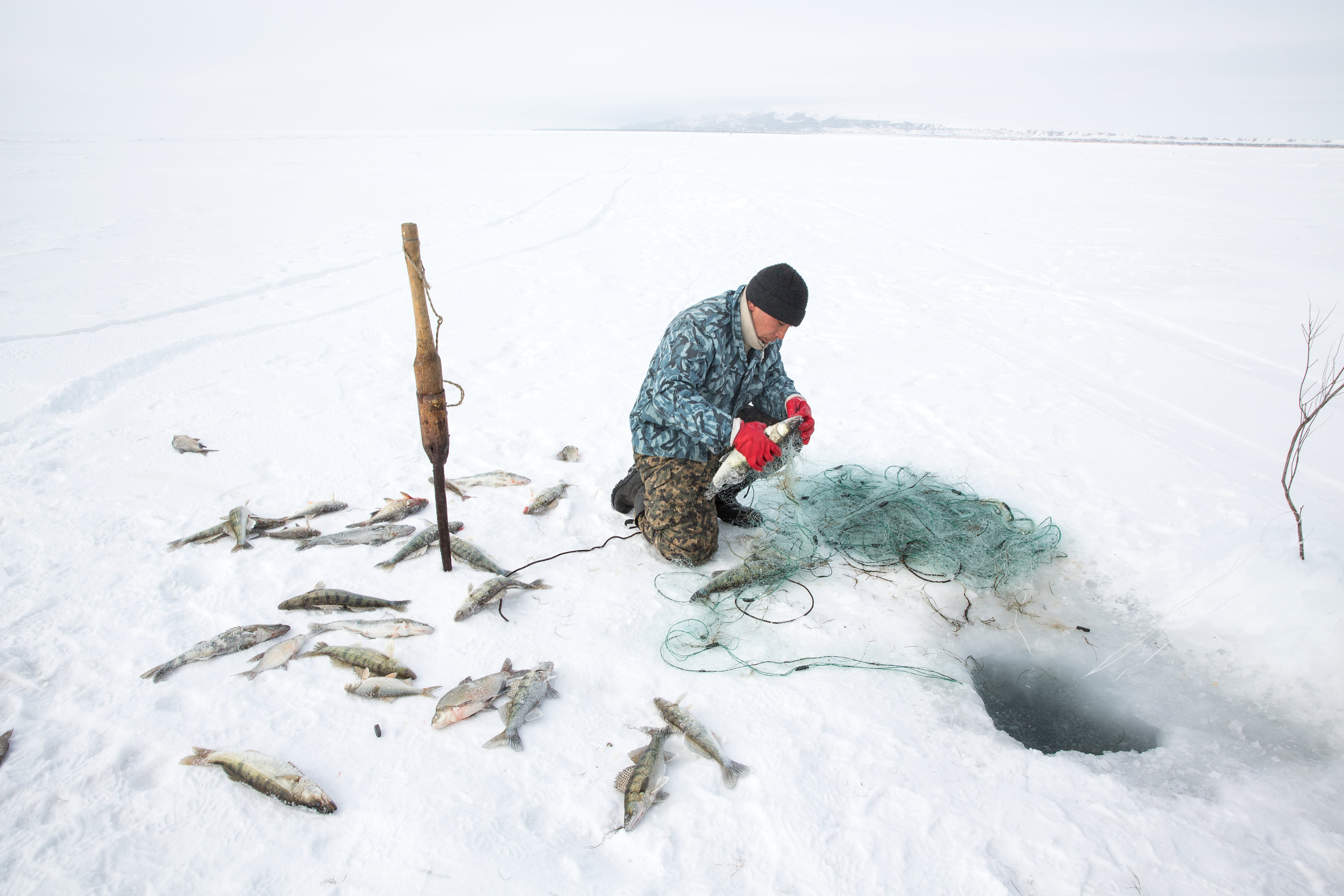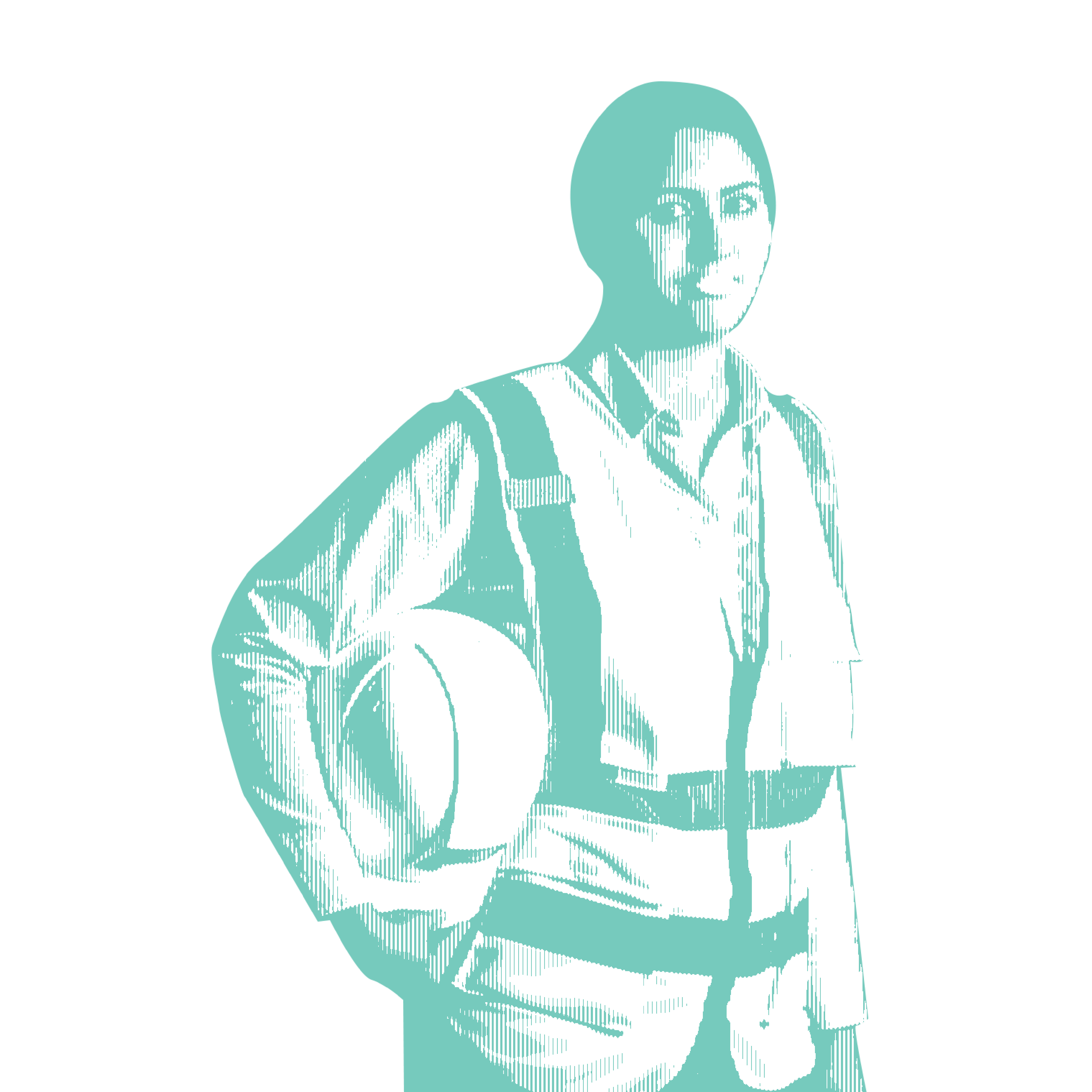ARALSK DISTRICT, KAZAKHSTAN–Omirserik Ibragimov fixed his gaze on the hole he had carved out from the frozen Aral Sea. The 25-year-old’s hands moved steadily, pulling out a fishing net that he and his father had left under the solid, snow-covered surface just three days earlier.
After a minute marked by tense silence, two breams emerged from the hole. Then three pike-perches, their silver scales shimmering as they struggled against the net’s green meshing.
“Here comes the gold,” Omirserik said with a smile as he continued tugging the net. The pike-perch, with its tender flesh and few bones, is considered to be the most valuable catch, selling for roughly 650 tenge (a little over $2) for a kilogram; local fishermen refer to them as “gold fish.”
His father, Kidirbai, worked with his bare hands to free the fish, his knuckles flush from the freezing water. After gathering all their nets, their total catch of the day was about 77 pounds (35 kilograms) of pike-perch and 44 pounds (20 kilograms) of bream—a sizable haul for a few hours of work.
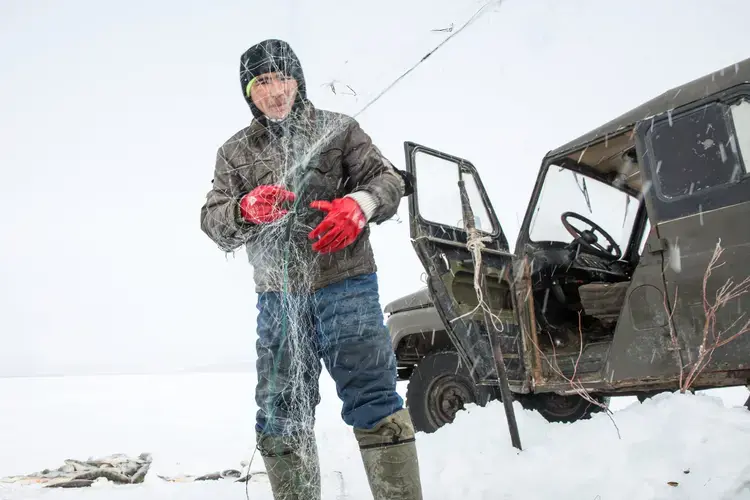
Just 15 years earlier, this would not have been possible. Once the world’s fourth-largest freshwater lake, with an area of some 26,000 square miles, the Aral Sea became the victim of the Soviet Union’s agricultural policies in the 1950s. Water from its two river sources—the Amu Darya and Syr Darya—was intentionally diverted for cotton cultivation.
As decreasing water flow into the sea caused a rise in salinity, the abundant freshwater fish species began to die out. By the 1980s, the fishing industry in the Aralsk district—once a robust source of employment for the region—was wiped out, forcing a mass migration of people. The remaining population was hit by extreme weather, brought on by the dried-out Aral seabed, and deteriorating health.
“The people destroyed the sea and then nature took revenge on the people,” said Madi Zhasekenov, the director of the Aralsk Regional Museum and Fishermen Museum.
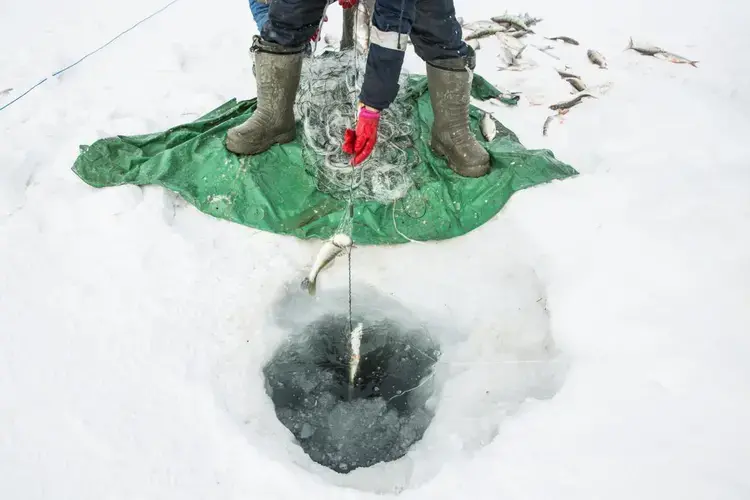
Massive Disaster
This rapid collapse over less than three decades—which environmental scientists say is one of the planet’s worst ecological disasters—is marked today by the sea’s reduced size. Its total area of water, straddling Kazakhstan and Uzbekistan, is now a tenth of its original size. What’s left has broken into two distinct bodies: the North and South Aral Seas. In Uzbekistan, the entire eastern basin of the South Aral Sea is completely desiccated, leaving merely a single strip of water in the west.
But Kazakhstan’s North Aral Sea has seen a happier outcome, thanks to a nearly $86 million project financed in large part by the World Bank. Along with repairs to existing dikes around the basin to prevent spillage, an eight-mile dam was constructed just south of the Syr Darya River. Completed in the summer of 2005, this dam, named Kokaral, surpassed all expectations. It led to an 11-foot increase in water levels after just seven months—a goal that scientists initially expected would take three years.
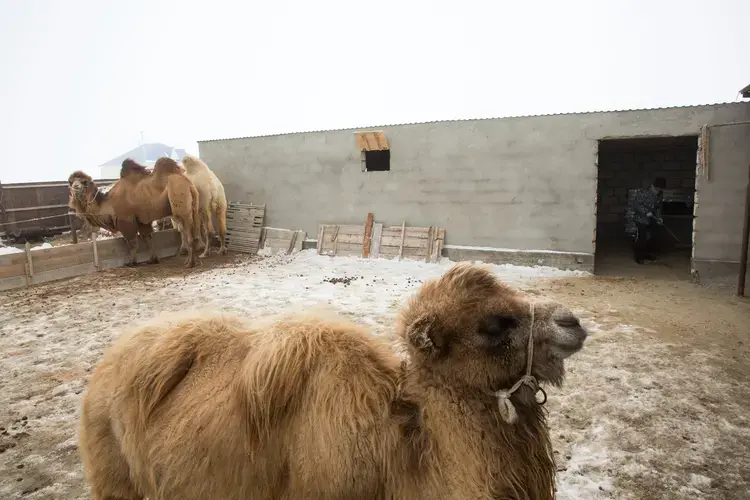
This turnaround in the North Aral Sea’s fate has meant that the fish stocks have returned to its waters, injecting new life into the local communities. Just as government policies had doomed the Aral Sea, careful planning and research helped revive at least part of it.
Kristopher White, a researcher and professor of Almaty’s KIMEP University who has studied the economic impacts of the Aral Sea’s desiccation, explained that while the sea will never return to its former size, the 18 percent increase in mass of the North Aral Sea is a testament to how political will and scientific research can benefit the environment.
"Anthropogenic ecological damage can be reversed by human intervention,” said White.
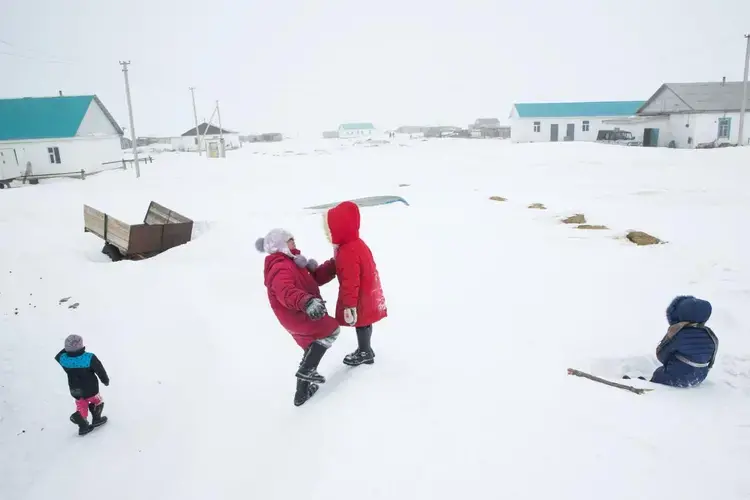
Optimism and Hope
At its peak in 1957, the Aral Sea produced more than 48,000 tons of fish, representing roughly 13 percent of the Soviet Union’s fish stocks. By the 1980s, due to the rising salinity of the sea, the 20 native species of fish were decimated; commercial harvests plummeted to zero by 1987. The water from the sea receded, and today, the shore is about 12 miles (20 kilometers) from Aralsk.
“The major source of employment was gone, and with it optimism and hope for the future,” said White. “And that really prevailed throughout the region until the completion of this dam.”
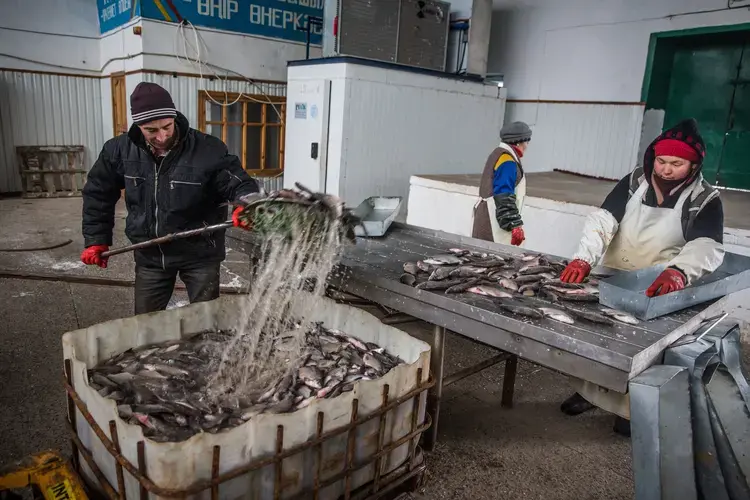
During those decades, flounder was the only fish that could survive the high-salinity North Aral Sea. But after the Kokaral Dam was finished, the average salinity dropped from 30 grams to 8 grams per liter, prompting the return of almost two dozen freshwater species through the Syr Darya river.
According to the Aralsk Fish Inspection Unit, fish catch in the North Aral Sea has grown six-fold since 2006, when the bulk of the 1,360 tons caught was flounder. By 2016, 7,106 tons of fish was caught, with bream being the most common, followed by roach and the sought-after pike-perch. For 2018, the fishing limit is set at 8,200 tons, said head inspector Esenbai Ensepov.
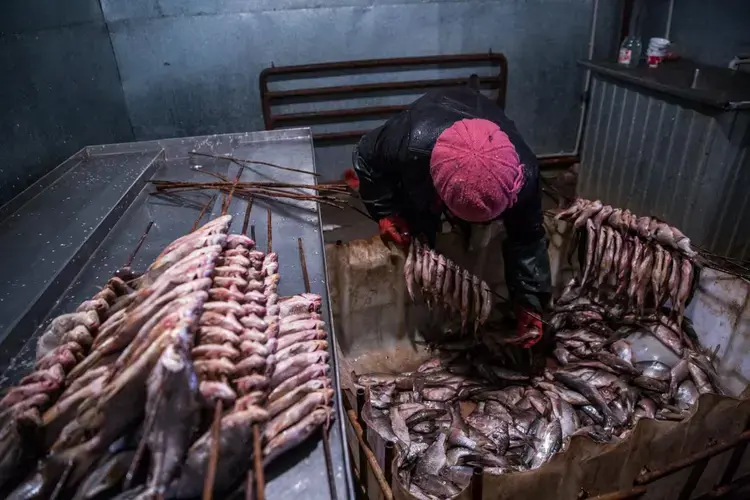
This return has brought commerce back to the inland town of Aralsk. Askar Zhumashev, 42, a supervisor at Kambala Balyk Processing Plant, said that his team processed roughly 500 tons of fish two years ago, the biggest amount since he started working there.
“When I was born, the sea was already gone,” said Zhumashev. “I went to the Aral Sea for the first time only two years ago. My parents used to tell me that the boats would come in and out everyday from the old port.”

Growing Prosperity–and Problems
In the winter, the village of Tastubek, about four hours from Aralsk, appears desolate. But around 10 AM every morning, the town hums to life as the fishermen begin gathering to inspect their gear and discuss the day’s plans. With the Aral Sea just an hour’s drive away, they can be back in the village by the late afternoon with a successful haul.
Kidirbai, the patriarch of the Ibragimov family, has witnessed the changing fortunes of Tastubek. He was born here in 1973. Unlike those forced to move during the bleak years, his family relied on their livestock of camels and horses for income. When he was a young boy, there were 90 houses in Tastubek.
“By the mid-90s, there were only nine houses left,” he said. This year, he counted 34, an increase from last year’s 29. The newcomers are young fishermen attempting to strike gold. “I am happy the village is growing because then maybe the government will pay more attention to us, like they would build a road or support the village,” said Kidirbai.

But prosperity has also generated some negative effects, like the raft of illegal fishing during the breeding season of May to July. Aldanbek Kerinov, a former taxi driver from Aralsk who started fishing full-time with his brothers seven years ago, explained that this period, well legally off limits, is considered the most bountiful because fish swim closer to the shore to lay their eggs.
“Everyone usually goes late at night, because during the day, everyone is afraid the fish inspectors will come,” he said. “There are no other jobs and fishing is the main source of income, so they will always continue to fish.”
Aldanbek was unconcerned about the impact this would have on the fisheries, as the World Bank’s second phase to the dam is touted to bring more water and thus more fish, he said. (While a plan to raise the Kokaral Dam’s walls to increase water levels has been in the works for years, a World Bank representative said that the government needs to approve the project in order for it to move forward.)
Yet the illegal fishing does worry experts like White, who points out that illicit harvests are much harder to track for management purposes. And the history of fishing has been rife with loose or no management, followed by collapse of stocks.
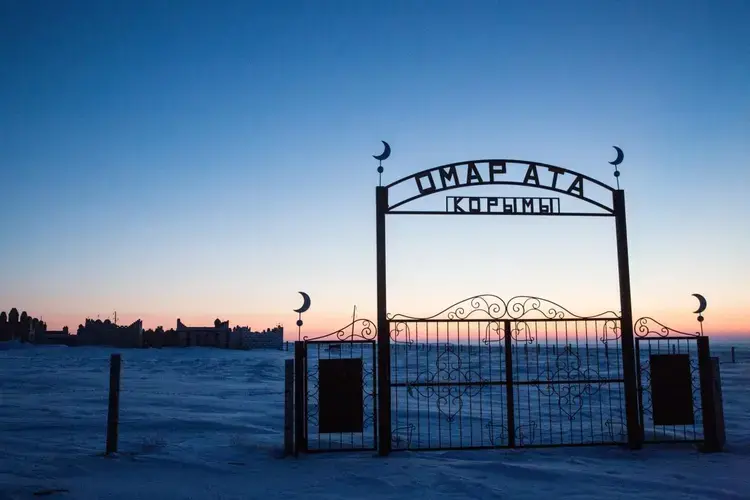
For Kirdirbai, the sea has been an unpredictable force in his life. In 1987, the water froze unexpectedly early in November, and his family’s fishing boat was stuck a thousand feet (300 meters) out in the sea. His father, worried about thin ice, tied a rope to himself and shuffled out from shore to retrieve it. Fourteen-year-old Kidirbai watched as his father freed the craft from the ice with a metal spike and dragged it back, without incident.
Five years later, Kidirbai was not so lucky. He and his friend were fishing in the summer when a big storm hit. The boat overturned and his friend drowned. Kidirbai, traumatized by the incident, stopped fishing for three years.
Yes, it is bad to fish during the breeding season, Kidirbai said. But after decades of poverty and harsh living, they were all hungry for prosperity. “Now the locals are thinking only about how to earn as much as possible,” he said.
His faith in the Aral Sea remains unwavering. Since the freshwater fish species have returned, Kidirbai—who could never fathom living anywhere else—is determined that his son has a future there as well.
“The sea is the source of life for us,” he said. “Next year, I am going to build a new house for him. My son will get married and he will continue fishing.”
With reporting contributions by Serik Dyussenbayev



